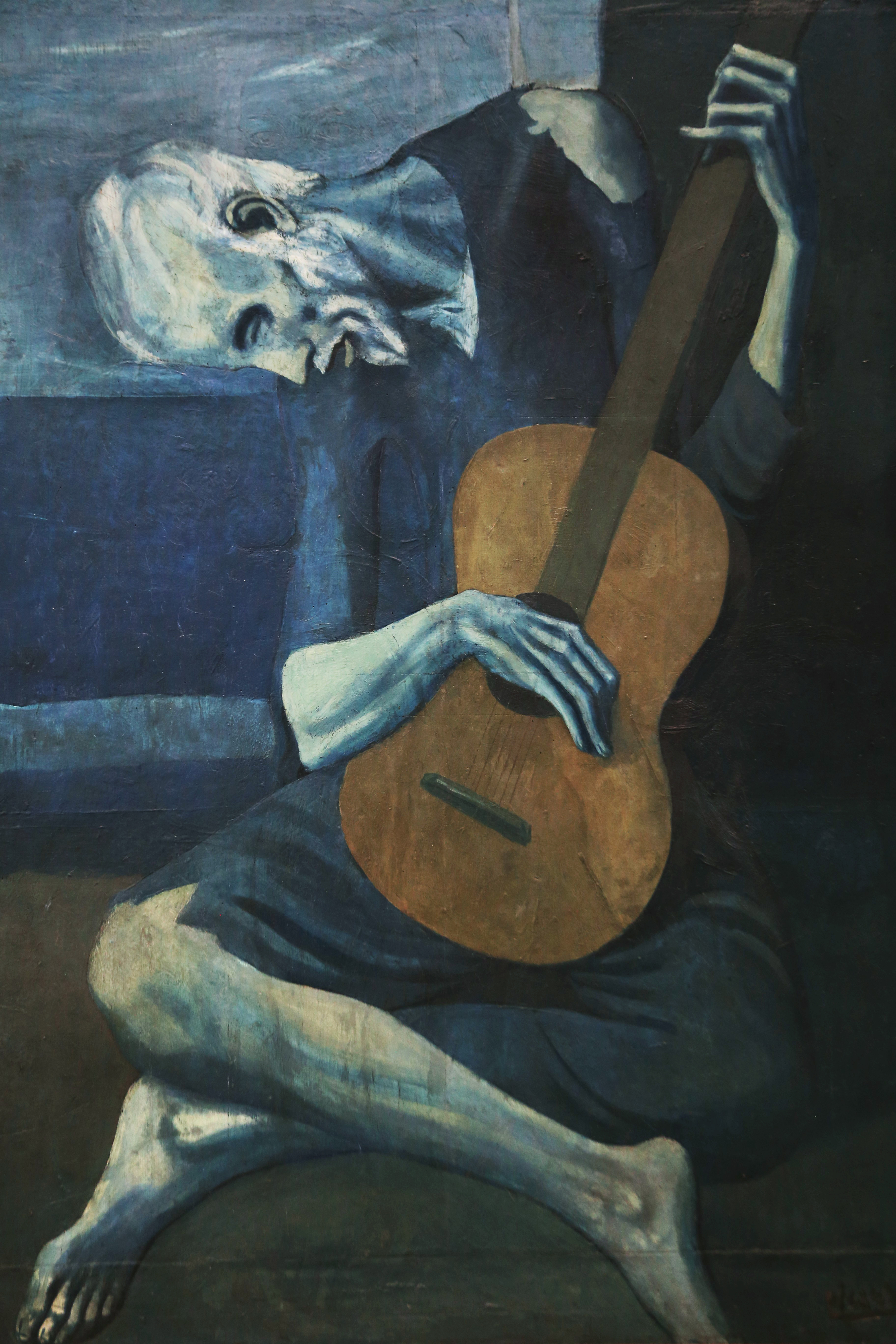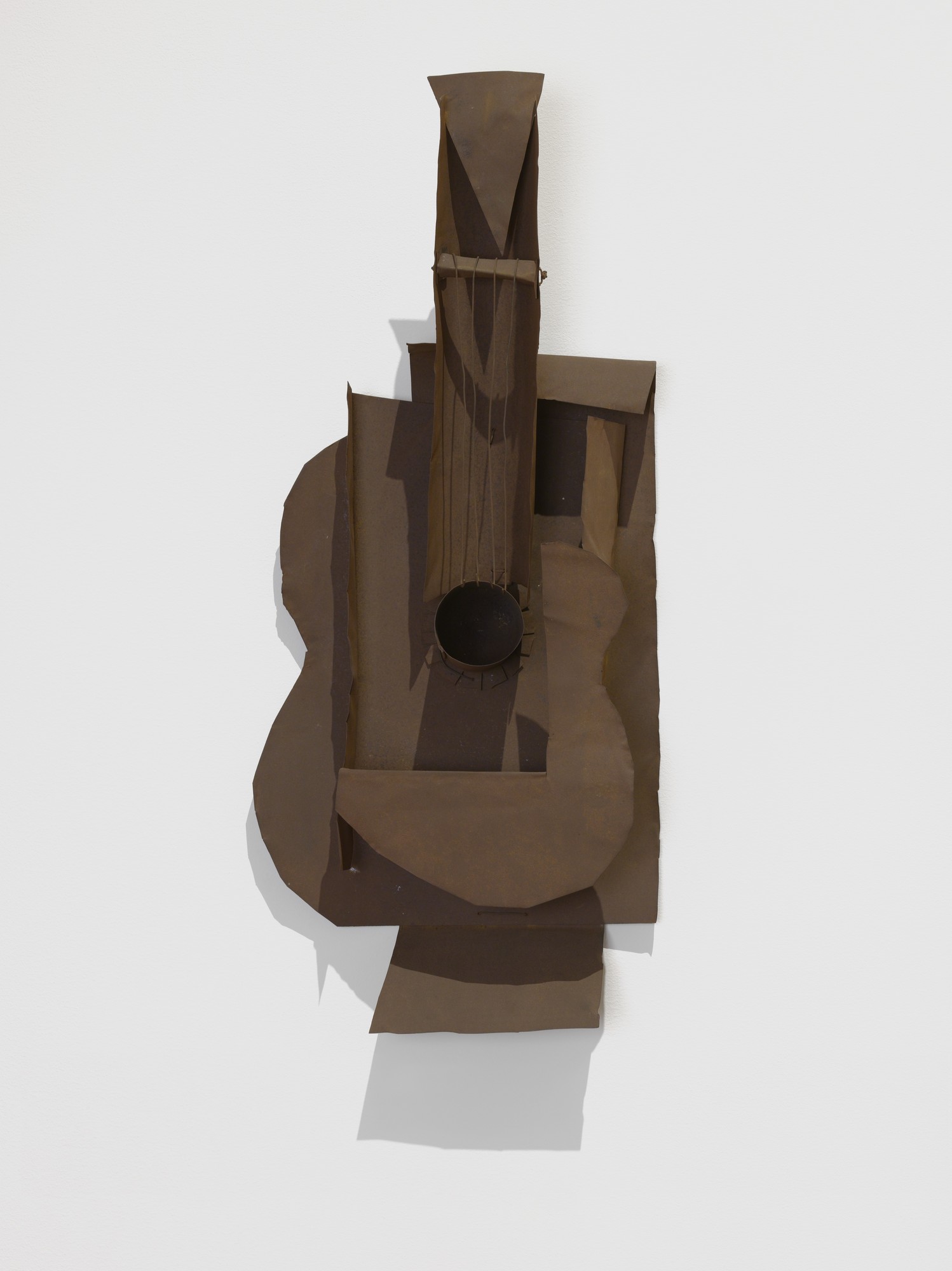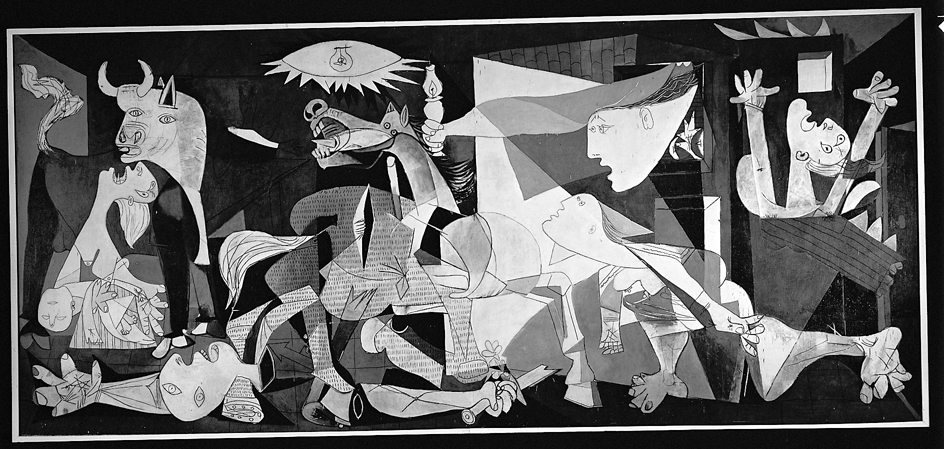Picasso, << pih KAH soh, >> Pablo (1881-1973), was the dominant figure in art of the 1900’s. Picasso was primarily a painter, but he also exerted a great influence on printmaking, sculpture, ceramics, drawings, and designs for the theater. All modern artists have been influenced by Picasso’s work, either directly or indirectly.

Early life.
Pablo Ruiz Picasso was born on Oct. 25, 1881, in Málaga, Spain. In 1895, after living in La Caruna for nearly four years, his family moved to Barcelona. Picasso learned the basic skills of painting from his father, Jose Ruiz Blanco, an artist and art teacher. In 1897 and 1898, Picasso lived in Madrid, where he spent much time in the Prado museum studying paintings by the great artists who lived before him. He returned to Barcelona in 1899.
The Blue Period.
Picasso’s artist friends in Barcelona eventually introduced him to the art world in Paris. He made several lengthy visits to Paris before settling there permanently in 1904. From 1901 to 1904, he developed a style known as his Blue Period. During this period, Picasso painted primarily in blue colors, evoking a feeling of sadness and alienation. A classic of the period is The Old Guitarist (1903). It is typical of Picasso’s subjects during this period, which featured the poor of Paris, such as beggars and starving children. The guitarist’s stretched-out, distorted body and impossibly long fingers indicate the influence of El Greco, a painter who worked in Spain during the late 1500’s and early 1600’s.

After Picasso finally settled in Paris, he moved into a tenement in the Montmartre section, nicknamed the Bateau Lavoir (Laundry Boat) for the laundry barges that docked on the Seine River there. He lived in the Bateau Lavoir until 1909, with a growing circle of friends, notably painters, poets, actors, and critics.
The Rose Period.
In late 1904, Picasso expanded his selection of colors, emphasizing rose and pink. At the same time, he eased the sadness of his subjects. This new style, called the Rose Period, concentrated on acrobats who traveled from town to town. They were called saltimbanques and often dressed as the harlequin (masked clown) characters who were popular in the traditional Italian theater commedia dell’arte and in pantomimes. Picasso often visited the Cirque Medrano near his Montmartre studio, which stimulated his interest in circus subjects. The appearance of circus figures in Picasso’s art coincided with his friendship with the French poet Guillaume Apollinaire, whose verse is filled with references to harlequins and saltimbanques as symbols of both friendship and alienation.
The masterpiece of the Rose Period is Family of Saltimbanques (1905). At about 7 feet (2.1 meters) high and 7.5 feet (2.3 meters) wide, it was the largest painting of both the Blue and Rose periods. The painting displays almost no activity. The characters hardly notice each other. The stillness of the scene lends it mystery and a sense of melancholy. Picasso portrayed himself as Harlequin, as he did in many paintings. With the self portrait, this painting reflects Picasso’s sense of artistic isolation or alienation. Family of Saltimbanques includes one figure thought to be from the Cirque Medrano, El Tio Pepe, a fat man in a bright red suit. The identity of the remaining figures remains controversial. Some scholars believe they represent Picasso’s friends of the time.
Before Picasso completed Family of Saltimbanques, his work came to the attention of the American writer Gertrude Stein. Stein had lived in Paris since 1903 and was building one of the foremost collections of modern art in Paris. She met Picasso in 1905 and introduced him to the French painter Henri Matisse in 1906.
Early sculptures.
In the summer of 1906, Picasso traveled to Gosol, a remote village in the Pyrenees mountains. Before he left for Gosol, he had discovered sculpture of the Iberian peninsula (present-day Spain and Portugal) from the 500’s and 400’s B.C. Under the influence of ancient Iberian sculpture, Picasso began to experiment with distortion as an expressive element.
At the 1906 annual exhibition in Paris, called the Salon d’Automne, Picasso saw the work of the French artist Paul Gauguin in carved wood along with 10 paintings by the French painter Paul Cezanne. The achievements of these two artists and his response to them preoccupied Picasso over the next year or so and helped define his later work. Gauguin’s use of forms found in the Pacific Islands, especially Tahiti, provided Picasso with an important model for using the art of non-Western cultures in his work.
Upon his return to Paris after that summer, Picasso completed a portrait of Gertrude Stein, begun months earlier. He gave the portrait a sculpturelike appearance by painting Stein with a masklike face and massive body of monumental chiseled forms.
Les Demoiselles d’Avignon
is a large painting Picasso completed in 1907. Many art historians consider it the most influential painting of the 1900’s because it opened the way to modern art. The picture portrays five demoiselles (young women), prostitutes from Avignon Street in Barcelona, which Picasso knew well. Picasso reduced the figures to a series of interlocking, angular shapes. He filled the composition with sharp planes, distortions of space, and deliberately disorienting and contradictory points of view. Picasso used this distortion of the female form to express his anxieties about women, love, and sexuality. The painting reveals Picasso’s attempt to harness the forms of non-Western carving and the power of magic and ritual in African art.

Cubism.
Picasso and the French artist Georges Braque became acquainted in 1907, and a remarkable artistic dialogue between the two began in 1908. Together they produced a revolutionary style called Cubism, in which figures and objects are represented by geometrical forms.
In 1909, Picasso and Braque entered a period of great intensity in their work together. Their pictorial vocabularies merged in a phase called Analytic Cubism. Analytic Cubism broke down forms from the natural world and reassembled them into flat planes.
During Picasso’s Cubist period, he often painted still lifes (pictures of fruit, bowls, bottles, and other everyday objects). He drew his subjects from cafes and artist’s studios, settings familiar to him. In 1912, the Cubist search for different styles of representation led Picasso to create Still Life with Chair Caning, and with it, to invent a technique called collage. Collage is a form of painting or drawing that attaches flat, ready-made materials to the surface (see Collage ). Still Life with Chair Caning shows objects scattered across a cafe table, including part of the newspaper Le Journal, a glass, and a lemon. To the painted objects, Picasso applied a real object, a piece of oilcloth printed with a pattern like chair caning. For a frame, Picasso surrounded the oval canvas with a length of thick hemp rope to make the collage look like an actual table.
Picasso also created illusions in his three-dimensional constructions, beginning in 1912 with a series of sculptures called Guitar. One of these works, which Picasso completed in 1913, is constructed of sheet metal and wire. He cut away most of the guitar body and expressed its shape as a series of flat, projecting planes. He made the guitar’s sound hole a projecting cylinder. In a real instrument, the hole would be an open space. Picasso’s use of sheet metal, an industrial material, was highly unusual at that time, but such materials have since become common sculptural mediums. His invention of this radical new sculptural form had a great influence on later developments in sculpture.

By 1912, Picasso discovered that he could give shapes different meanings—real or abstract—simply by rearranging them. he also found that he could use a variety of materials on surfaces. Collage and the Guitar construction essentially ended Picasso’s Analytic Cubist phase and he began a second phase, called Synthetic Cubism, which lasted into the early 1920’s. Synthetic Cubism generally constructed an image from many components. Instead of dissecting forms, as in Analytic Cubism, the artist added elements to the picture surface, building up the image through each addition, as Picasso did in Still Life with Chair Caning (1912).
When France joined World War I shortly after it began in 1914, Braque was called into the French military. Because Spain remained neutral during the war, Picasso continued working on art, but his collaboration with Braque came to an end.
Picasso as designer.
A friendship with the French writer Jean Cocteau brought Picasso into the social circle surrounding the Ballets Russes in 1919. The Ballets Russes was a touring Russian dance company that included some of the greatest dancers, composers, and artists of the time. The first ballet Picasso became involved in was Parade. Cocteau created the story, and Picasso designed the curtain, sets, and costumes. Parade premiered in 1917. Critics considered the ballet a radical break from traditional ballet, largely due to Picasso’s designs. He continued to work on ballets until 1924, while also painting such Synthetic Cubist works as Three Musicians (1921).
The 1920’s and 1930’s.
Picasso began to work in a different style in the 1920’s, one he practiced alongside Cubism. This style was his version of Neoclassicism inspired by a trip to Italy in 1917. The artist began to use Classical forms and drawing techniques, reflecting the influence of Mediterranean culture. Three Women at the Spring (1921) shows its Classical roots in the facial features and clothing of the large, serene figures.
Picasso never became an official member of the Surrealist group during the 1920’s, but he had close connections with several Surrealist members. The Surrealists used unexpected arrangements and distortions of images to reflect dreams and the subconscious mind (see Surrealism ). The Surrealist movement gave Picasso new subjects. It also reinforced his interest in the distortion of forms and the expression of subconscious emotions, qualities dating back to Les Demoiselles d’Avignon. Picasso’s own brand of Surrealism also found a unique expression in poetry. He began to write in the fall of 1935 and continued into 1936. During that time, he concentrated on poetry instead of painting.
In the mid-1930’s, Picasso resumed painting with a new political commitment. The outbreak of the Spanish Civil War in 1936 stirred Picasso to produce work supporting the cause of the Spanish Loyalists against the fascists led by Francisco Franco.
The weakened Spanish Loyalist government asked Picasso to paint a mural for the Spanish Pavilion at a Paris world’s fair in 1937. The artist struggled to find a subject for the mural until he was inspired by the bombing of the Spanish town of Guernica, ordered by Franco. Dramatic photographs of the destruction of the small town gave Picasso his subject matter.
Picasso painted Guernica in about a month in 1937. The canvas stretched more than 25.5 feet (7.8 meters) in length. The imagery of Guernica—a gored horse, a woman with a dead child, a fallen soldier—became powerful symbols of bitter suffering. To dramatize the wartime agony of destruction, the artist restricted his colors to stark black, white, and gray.

Later career.
After Germany invaded France in 1940, Picasso lived in his Paris studio, though he was banned from showing his work. Skulls began to appear in some of his paintings. They symbolized the tragedies that had touched the artist, including World War II (1939-1945), his mother’s death in 1939, and the death of his friend, the Spanish sculptor Julio Gonzalez in 1942.
After France was liberated in 1944, the Salon d’Automne of 1944 featured Picasso’s work of the war years. These somber paintings shocked viewers, as did the announcement that Picasso had joined the French Communist party. His anti-American painting Massacre in Korea (1951) depicts American soldiers as medieval knights slaughtering innocent women and children.
Beginning in 1948, Picasso lived and worked in the south of France, at first for part of the year and later permanently. His international reputation had expanded, and his name had became virtually synonymous with modern art.
During the final two decades of his life, Picasso became fascinated with earlier art. He based paintings on works by two masters of the 1600’s, the Dutch artist Rembrandt and the Spanish artist Diego Velazquez, and by French artists of the 1800’s, including Eugene Delacroix and Édouard Manet. Picasso pitted himself in competition with his chosen masters, breaking their work down, recomposing it, and becoming ever bolder in his methods of painting.
Picasso’s style continued to develop through the last decade of his life. At the time of his death on April 8, 1973, Picasso still owned hundreds of his own works in various mediums from all periods of his career. These pieces provided the basis of a gift to the French government by his heirs. In 1985, the Picasso Museum opened in Paris to display the works.

See also Painting (Cubism) ; Sculpture (Cubism and Futurism) .
